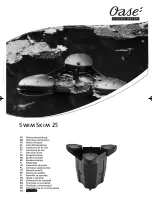
8 Decommissioning
8.1 Shutting down for longer periods
Before shutting down the vacuum pump, observe the following instructions to adequately protect the in-
terior of the vacuum pump (suction chamber) from corrosion:
1. Switch off the vacuum pump.
2. Vent the vacuum pump.
3. Allow the vacuum pump to cool down.
4. Clean suction chamber.
5. Change the operating fluid.
6. Start the vacuum pump and take it up to operating temperature in order to wet the inside of the
pumping system with fresh operating fluid.
7. Fill the vacuum pump to above the
“max.” mark
with operating fluid, up to the upper edge of the
sight glass.
8. Seal the vacuum and fore-vacuum flanges as well as any other openings with blind flanges from
9. Store the vacuum pump in dry, dust-free rooms, within the specified ambient conditions.
10. Pack the vacuum pump together with a drying agent in a plastic bag, and seal the vacuum pump
airtight if it is to be stored in rooms with damp or aggressive atmospheres.
11. For longer storage periods (> 2 years), Pfeiffer Vacuum recommends changing the operating fluid
again prior to recommissioning.
8.2 Recommissioning
NOTICE
Risk of damage to vacuum pump as a result of operating fluid aging
The operating fluid usability is limited (max. 2 years). Prior to recommissioning, following a shutdown
of
2 years or more
, carry out the following work.
► Change the operating fluid.
► Change the radial shaft seal rings and other elastomer parts if required.
► Observe the maintenance instructions – consult Pfeiffer Vacuum if necessary.
Ejection of operating fluid
Overfilled operating fluid will be ejected at the exhaust connection when starting up the
vacuum pump.
● Reduce the operating fluid level to the normal level before recommissioning.
Decommissioning
43/62
















































